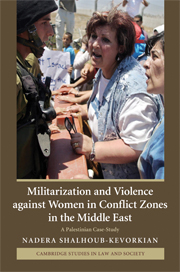 Militarization and Violence against Women in Conflict Zones in the Middle East
Militarization and Violence against Women in Conflict Zones in the Middle East Book contents
- Frontmatter
- Contents
- List of figures
- Acknowledgements
- 1 Introduction
- 2 Violent translations: women, war, and narrative in conflict zones
- 3 Veiled powers: conceptualizing woman and/as the ‘nation’
- 4 Women frontliners in conflict zones: a genealogy of weaponization
- 5 Speaking truth to power: voices of Palestinian women facing the Wall
- 6 Ruminations and final thoughts: women in-between
- References
- Index
6 - Ruminations and final thoughts: women in-between
Published online by Cambridge University Press: 23 January 2010
- Frontmatter
- Contents
- List of figures
- Acknowledgements
- 1 Introduction
- 2 Violent translations: women, war, and narrative in conflict zones
- 3 Veiled powers: conceptualizing woman and/as the ‘nation’
- 4 Women frontliners in conflict zones: a genealogy of weaponization
- 5 Speaking truth to power: voices of Palestinian women facing the Wall
- 6 Ruminations and final thoughts: women in-between
- References
- Index
Summary
As a child growing up in a Palestinian family, I always wondered how my mother, my mother-in-law, and all the women I encountered had managed to endure all that they had experienced. Looking at Palestinian women today, including my own daughters, I realize how the generations that came before us prepared us for our current ordeals. The everyday struggle to survive the violent effects of the colonial-settler project and the constant political hardships that Palestinian women face – keeping their families and the social fabric intact, facing displacement and dislocation, enduring abuse – have enabled women to construct counter-spaces that allow them to survive and to envision that they might some day attain the justice they have so longed for.
While writing the concluding remarks that comprise this chapter, I became aware of the irony of the power vested in written texts as also a place of struggle and the meanings that may accrue to such texts. The menace of the Zionist war against the Palestinian entity, the courageous acts of the frontliners, the massacres, the Nakba, the Naksa, the constant battles – these have formed my background as well as the framework of my present existence much more so than the daily activities of family life. My aim in this concluding chapter is to attempt a summary of the archaeology and technology of domination primarily through the lens of my own experiences and reminiscences.
- Type
- Chapter
- Information
- Militarization and Violence against Women in Conflict Zones in the Middle EastA Palestinian Case-Study, pp. 187 - 213Publisher: Cambridge University PressPrint publication year: 2009
